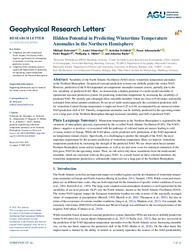Hidden Potential in Predicting Wintertime Temperature Anomalies in the Northern Hemisphere
Ruggieri, Paolo
Müller, Wolfgang A.
DOI: https://doi.org/10.1029/2021GL095063
Persistent URL: http://resolver.sub.uni-goettingen.de/purl?gldocs-11858/10354
Persistent URL: http://resolver.sub.uni-goettingen.de/purl?gldocs-11858/10354
Supplement: https://cds.climate.copernicus.eu/cdsapp#!/dataset/seasonal-original-single-levels?tab=overview, http://www.ecmwf.int/en/forecasts/datasets
Dobrynin, Mikhail; Düsterhus, André; Fröhlich, Kristina; Athanasiadis, Panos; Ruggieri, Paolo; Müller, Wolfgang A.; Baehr, Johanna, 2022: Hidden Potential in Predicting Wintertime Temperature Anomalies in the Northern Hemisphere. In: Geophysical Research Letters, Band 49, 20, DOI: 10.1029/2021GL095063.
 |
Dokument öffnen: |
Variability of the North Atlantic Oscillation (NAO) drives wintertime temperature anomalies in the Northern Hemisphere. Dynamical seasonal prediction systems can skilfully predict the winter NAO. However, prediction of the NAO‐dependent air temperature anomalies remains elusive, partially due to the low variability of predicted NAO. Here, we demonstrate a hidden potential of a multi‐model ensemble of operational seasonal prediction systems for predicting wintertime temperature by increasing the variability of predicted NAO. We identify and subsample those ensemble members which are close to NAO index statistically estimated from initial autumn conditions. In our novel multi‐model approach, the correlation prediction skill for wintertime Central Europe temperature is improved from 0.25 to 0.66, accompanied by an increased winter NAO prediction skill of 0.9. Thereby, temperature anomalies can be skilfully predicted for the upcoming winter over a large part of the Northern Hemisphere through increased variability and skill of predicted NAO. Plain Language Summary:
Wintertime temperature in the Northern Hemisphere is regulated by the variations of atmospheric pressure, represented by the so‐called North Atlantic Oscillation (NAO). The NAO's phase—negative or positive—is associated with the pathways of cold and warm air masses leading to cold or warm winters in Europe. While the NAO phase can be predicted well, predictions of the NAO‐dependent air temperature remain elusive. Specifically, it is challenging to predict the strength of the NAO, the most important requirement for the accurate prediction of wintertime temperature. Here, we improve wintertime temperature prediction by increasing the strength of the predicted NAO. We use observation based autumn Northern Hemisphere ocean and air temperature, as well as ice and snow cover for statistical estimation of the first guess NAO for the upcoming winter. Then, we sub‐select only those simulations from the multi‐model ensemble, which are consistent with our first guess NAO. As a result, based on these selected members, the wintertime temperature prediction is substantially improved over a large part of the Northern Hemisphere. Key Points:
Amplitude and skill of predicted North Atlantic Oscillation (NAO) improve significantly by subsampling of ensemble of existing seasonal prediction systems.
Amplified NAO variability leads to significant improvement in predicting the upcoming winter temperature anomalies in the Northern Hemisphere.
Statistik:
ZugriffsstatistikSammlung:
This is an open access article under the terms of the Creative Commons Attribution‐NonCommercial‐NoDerivs License, which permits use and distribution in any medium, provided the original work is properly cited, the use is non‐commercial and no modifications or adaptations are made.

